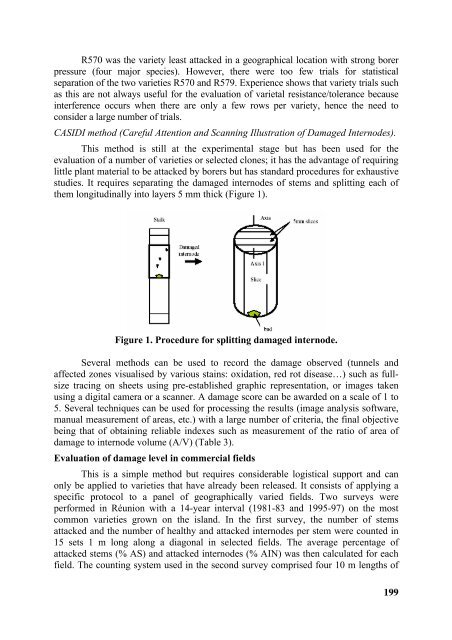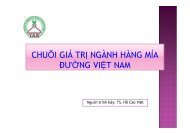TUYEÅN TAÄP
tuyeÃ¥n taäp - CHUYÃN TRANG GIá»I THIá»U CÃC GIá»NG MÃA Tá»T ...
tuyeÃ¥n taäp - CHUYÃN TRANG GIá»I THIá»U CÃC GIá»NG MÃA Tá»T ...
- No tags were found...
Create successful ePaper yourself
Turn your PDF publications into a flip-book with our unique Google optimized e-Paper software.
R570 was the variety least attacked in a geographical location with strong borer<br />
pressure (four major species). However, there were too few trials for statistical<br />
separation of the two varieties R570 and R579. Experience shows that variety trials such<br />
as this are not always useful for the evaluation of varietal resistance/tolerance because<br />
interference occurs when there are only a few rows per variety, hence the need to<br />
consider a large number of trials.<br />
CASIDI method (Careful Attention and Scanning Illustration of Damaged Internodes).<br />
This method is still at the experimental stage but has been used for the<br />
evaluation of a number of varieties or selected clones; it has the advantage of requiring<br />
little plant material to be attacked by borers but has standard procedures for exhaustive<br />
studies. It requires separating the damaged internodes of stems and splitting each of<br />
them longitudinally into layers 5 mm thick (Figure 1).<br />
Figure 1. Procedure for splitting damaged internode.<br />
Several methods can be used to record the damage observed (tunnels and<br />
affected zones visualised by various stains: oxidation, red rot disease…) such as fullsize<br />
tracing on sheets using pre-established graphic representation, or images taken<br />
using a digital camera or a scanner. A damage score can be awarded on a scale of 1 to<br />
5. Several techniques can be used for processing the results (image analysis software,<br />
manual measurement of areas, etc.) with a large number of criteria, the final objective<br />
being that of obtaining reliable indexes such as measurement of the ratio of area of<br />
damage to internode volume (A/V) (Table 3).<br />
Evaluation of damage level in commercial fields<br />
This is a simple method but requires considerable logistical support and can<br />
only be applied to varieties that have already been released. It consists of applying a<br />
specific protocol to a panel of geographically varied fields. Two surveys were<br />
performed in Réunion with a 14-year interval (1981-83 and 1995-97) on the most<br />
common varieties grown on the island. In the first survey, the number of stems<br />
attacked and the number of healthy and attacked internodes per stem were counted in<br />
15 sets 1 m long along a diagonal in selected fields. The average percentage of<br />
attacked stems (% AS) and attacked internodes (% AIN) was then calculated for each<br />
field. The counting system used in the second survey comprised four 10 m lengths of<br />
199






